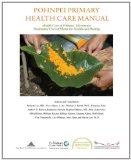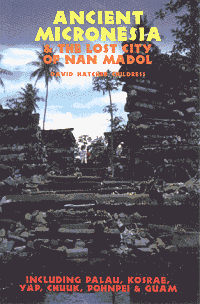Ponape Island 6.53N 158.16e
Situated in the Caroline Islands
a.k.a. Ponape, Nan Matol, Ascension IslandNan Madol is one of the most remarkable ruins in the world, covering at least 11 square miles. The above-water ruins cover several acres and are built from basalt blocks weighing as much as 50 tons, with walls which rise to 10 metres. Pottery shards have been dated to at least 2000 years old. Similar smaller ruins may be found on the island of Kosrae some 560 km to the southeast.
Ponapean legends about the origin of Nan Matol
(Author unknown)"The story that Hambruch [A German anthropologist who visited Ponape in 1908-10] heard about the building of Nan Matol tells how two young wizards, Olo-Sipe and Olo-Sopa [or: Olo-Shipe and Olo-Shaupa], set out from Jokaz [a nearby island] to build a great cult center to the gods, demons, and ghosts. They tried several places on the coasts of Ponape, but each time the wind and the surf destroyed their handiwork. At last they found their ideal site at Temuen. A mighty spell made the basaltic prisms on Jokaz fly through the air and settle down in the right positions to form Nan Matol....
"Until recent times Nan Matol was used as a center for the worship of the turtle god Nanusunsap. Whenever the Ponapeans caught a sea turtle, they brought it to Nan Matol and kept it in one of the buildings. When the tribe was assembled, the priests anointed the turtle with coconut oil and hung it with ornaments. The priests loaded the turtle into a boat and paddled about the canals of Nan Matol, while one priest stared at the turtle and blinked his eyes every time the turtle blinked. When they arrived at Pan Katera, where a fire had been lit, a priest killed the turtle by breaking its shell with a club. The turtle was cut up, cooked, and served to the priests and the king, with prayers and ritual. "In the reign of the Nan-Marki Luk-En-Mueiu, about 1800, the ritual was brought to an end in a ridiculous fashion. At one ceremony, a priest got no roast turtle. He walked out in a rage, howling curses, and went off to live by himself on a sand bank and eat eels. [Compare the American children's song: "Nobody likes me, everybody hates me, guess I'll go eat worms.'' It goes on to describe the gastronomic delights of annelidophagy in detail.] The Metalanimians [i.e. natives] feared that he had so profaned the ceremony that they could no longer hold it.
"The Ponapeans also had myths about a dragon or giant lizard. In one version, the dragon lived in Jokaz and gave birth to two girls. When the girls grew up, they married the reigning Satalur and asked their husband to let their mother come to live in Nan Matol. When he assented, the dragon moved into one of the buildings, excavating the canals of Nan Matol in the process. ``Next morning, when the Satalur brought some food for his mother-in-law, he saw the dragon for the first time. In terror he burned up the house and the dragon. His wives jumped into the fire and burned themselves up too; and in his grief the Satalur did likewise. The likeliest explanation for the dragon myth is that Ponape was once visited by the New Guinean crocodile, a large man-eating species often found swimming in the open sea, where one would never expect to see a crocodile.'' (pp. 233-235 of L. Sprague and Catherine de Camp, Ancient Ruins and Archaeology.)
The de Camps begin their chapter on Nan Matol with the quotation
And there, in sombre splendour by the shore Of Hali dark,
an ancient city stood;
Black monolithic domes and towers loom Stark, gigantic in the starless gloom
Like druid menhirs in a haunted wood.
German archaeologist Dr. Paul Hambruch, who worked on the site at the turn of the century, suggests that a sunken city may surround Nakapw Island, near Nan Madol.
Archaeological investigations at Nan Madol: Islet maps and surface artifacts
by John Stephen Athens
from Pacific Studies Institute
Upon a stone altar: a history of the island of Pohnpei to 1890.
Diving and Snorkeling Chuuk Lagoon, Pohnpei and Kosrae (Pisces Guides)
by Tim Rock
Book Description: Hard-coral jewels in the heart of Micronesia, Chuuk Lagoon, Pohnpei and Kosrae offer unrivalled variety. Dive into history while exploring artifact-laden Japanese shipwrecks in Chuuk (formerly "Truk") Lagoon. Hike in Pohnpei's lush rainforests and dive its teeming inner lagoon. Marvel at Kosrae's protected reefs, which host some of the Pacific's healthiest corals. The tropical waters around these remote islands keep the year-round diving and snorkeling exceptional. From the shipwreck graveyard of Chuuk Lagoon to Pohnpei's remote atolls and Kosrae's pristine reefs, this guide coves 64 of the area's best dive sites, with full-colour photos throughout.You'll get specific information on:
Dive site depth range and suggested diving expertise Common and hazardous marine life Chuuk's WWII history, Pohnpei's Nan Madol ruins and Kosrae's marvelous mangrove reserves 14 easy-to-read maps
Paperback from Lonely Planet
Hanlon, David L. University of Hawaii Press, 1988.
A well researched book covering the history of the island from earliest myths and legends up to the early Western contact period.
ISBN 0824811240Nest in the wind: adventures in anthropology on a tropical island.
by Martha C. Ward
Personal account of one woman's stay on the island.
On a magnificent island in the middle of the Pacific lives a people who eat dogs, grow quarter-ton yams in secret, stage extraordinarily dramatic feasts, have exceptionally relaxed attitudes about sex, and ritually share a potent drink called kava. Nest in the Wind is a very personal record of the field experiences of a female anthropologist who managed a scientific research project on the lush, tropical island of Pohnpei in the early 1970s. Her picture of life on Pohnpei is gripping and accurate: living in a tin shack, speaking a new language, observing manners and following customs, finding food, adopting a son, earning a high title, becoming pregnant, and overcoming spells placed on her. The standard questions of ethnography, including family life, sex, childbirth, economics, politics, religion, medicine, magic and death, are thoroughly addressed, clothed in the easy format of personal experiences with real people. Amazon.com
Paperback (January 1989)
Waveland Press; ISBN: 0881334057
Related books on Anthropology
Power Sharing: Language, Rank, Gender, and Social Space in Pohnpei, Micronesia
Place Names of Pohnpei Island, Including And (Ant) and Pakin Atolls
by Thomas Panholzer, Rufino Mauricio
Paperback from The Bess Press
by Elizabeth Keating
Hardcover from Oxford University Press
Whisper of the Mother : From Menarche to Menopause Among Women in Pohnpei
by Maureen H. Fitzgerald, et al
Hardcover: 176 pages
Bergin & Garvey; ISBN: 0897898184;
Ethnobotany of Pohnpei: Plants, People, and Island Culture
by Michael J. Balick
Paperback from University of Hawaii Press
Pohnpei Primary Health Care Manual: Health Care in Pohnpei, Micronesia: Traditional Uses of Plants for Health and Healing.
by Roberta Lee, Nieve Shere L.Ac., Michael J. Balick Ph.D., Francisca Sohl, Andrew S. Roberts, Katherine Herrera, Stephen Dahmer M.D., Min Lieskovsky, Alfred Dores, William Raynor, Pelihter Raynor, Elipiana Albert, Molly Hunt, Clay Trauernicht, Lisa Offringa
Paperback from CreateSpace
The Royal Headley of Pohnpei: Upon a Stone Altar
Paperback from Trafford Publishing
Whisper of the Mother: From Menarche to Menopause Among Women in Pohnpei
by Maureen H. Fitzgerald
Hardcover from Praeger
Hydrogeology and ground-water resources of Ngatik Island, Sapwuahfik Atoll, State of Pohnpei, Federated States of Micronesia
by Stephen S. Anthony
Paperback from University of Michigan Library
Upon a Stone Altar: A History of the Island of Pohnpei to 1890 (Pacific Islands Monograph Series)
by David L. Hanlon
Hardcover from University of Hawaii PressThe Lost City of Stone : The Story of Nan Madol, the 'Atlantis' of the Pacific
Ancient Micronesia & the Lost City of Nan Madol : Including Palau, Yap, Kosrae, Chuuk & the Marianas
by David Hatcher Childress
Paperback - 232 pages
Scb Distributors; ISBN: 0932813496
Out of Print - Try Used Books
by William Sanborn Ballinger
Out of Print - Try Used BooksBroken Canoe by Ann Nakano
Out of Print - Try Used BooksNotes from Broken Canoe by Ann Nakano:
Sokehs Rock, pronounced Jokaj, guards the entrance to Ponape. Ponape has five "principalities": Madolenihmw, U, Kitti, Net and Sohehs, in order of current importance. Kapingamarangi & Nukuoro atolls are part of Ponape. Kosrae was originally a part of Ponape, but seceded, and is now a self governing state of the FSM, along with Ponape, Truk, and Yap. Nan Madol is probably site of most impressive ruins. Myths of Nan Madol etc see p246. Description of ruins starts on p270. Ruins are made of basalt. Some legends say ruins are from pre-historic times, but archaeologists say dates nearer 13th century. Governor Berg died mysteriously 1907, pursued by ghostly trumpets. Main ruins on Madolenihm, others on Kitti, Net & U.
Nan Madol is 60 hectares, all connected by shallow canals. It consists of 92 man made islets. Ann Nakano says "They were obviously built by a people who had the sophistication of the ancient Egyptians and who disappeared as mysteriously as the Peruvian Incas. Nan Dowas is the nearest islet (to Ponape?), and archaeologists say more complex than the others. Perfectly sized basalt logs are stacked in crib-like fashion to a height of 6 metres. Map of Nan Madol available from the tourist office.
Notes from Lost Worlds Robert Charoux p102:
Ponape in the Carolines, which are strewn with ruins: large temple & a megalithic harbour w/canals. Churchward says temple built over network of cellars & crypts connected to a canal, and that at its centre is a room in the shape of a pyramid. Similar ruins (to Ponape) at Kusaie, in Carolines, near village of Lele. Huge enclosure and cone shaped hill surrounded by high walls. Natives say people here were very powerful & travelled east & west in great vessels.Pohnpei, an island argosy. Ashby, Gene. Rainy Day Press, Rev. ed 1987.
Written by a longtime resident of Pohnpei, this guidebook is a good source of information about the island. 317 p. ISBN 0931742145.
Out of Print - Try Used BooksMicronesia handbook: guide to the Caroline, Gilbert, Mariana, and Marshall islands.
Stanley, David. Moon Publications, 1992. ISBN 0918373808
Out of Print - Try Used BooksWe, the Navigators.
Lewis, David. University of Hawaii Press & ANU, 1972. The result of a research grant from the Australian National University to study indigenous navigation practices in the Pacific.ISBN 0824803949
Out of Print - Try Used BooksSome things of value: Micronesian customs and beliefs.
Ashby, Gene (compiler/editor).
Rainy Day Press, 1983.
Collection of traditions written by the students of the Community College of Micronesia (Kolonia, Pohnpei). ISBN 0931742129
Out of Print - Try Used BooksNever and always: Micronesian legends, fables, and folklore.
Ashby, Gene (compiler/editor) and Thomas Joel (illustrator).
Rainy Day Press, 1989.
Another collection by the students of students of the Community College of Micronesia. ISBN 0931742110
Out of Print - Try Used BooksPonapean-English dictionary. Rehg, Kenneth L. and Damian G. Sohl. PALI language texts -- Micronesia. University Press of Hawaii, 1979. ISBN 0824805623
Out of Print - Try Used BooksPonapean reference grammar. Rehg, Kenneth L. and Damian G. Sohl. PALI language texts -- Micronesia. University Press of Hawaii, 1981. Contains a detailed analysis of the elements of Pohnpeian speech. ISBN 0824807189
Out of Print - Try Used BooksPwuhk Sarawi: Audaudki Kadehde Mering Oh Kadehde Kapw Ni Mahsen En Pohnpei (Holy Bible: The Old Testament and New Testament in the Pohnpeian Language). United Bible Societies, 1994.
Out of Print - Try Used BooksDer Mosslose Ozean (The Measureless Ocean)
by Herbert Rittlinger
Published Stuttgart, Germany, 1939.
Out of Print - Try Used Books
The following adapted from Brittanica c1996
Pohnpei is a high coral-capped volcanic island in the eastern Caroline Islands in the western Pacific, which, with a number of nearby atolls constitute a state in the Federated States of Micronesia.
Surrounded by a barrier reef with many small islets, Pohnpei has an area of 334 square km, rises to 2,593 feet on Mount Totolom, and is subject to heavy rainfall which in combination with fertile soil and tropical climate results in luxuriant year-round growth. Brittanica goes on to say "It has mangrove swamps along its coasts and rain forest in the central hilly area. Situated near Pohnpei are the low-lying coral atolls of Oroluk, Pakin, and Ant to the west; Ngatik, Nukuoro, and Kapingamarangi atolls to the southwest; and Mokil and Pingelap atolls to the east. Most of the coral atolls are wooded and support coconut palms. The native people, with the exception of the Polynesian inhabitants of Nukuoro and Kapingamarangi, are Micronesians."Nan Madol is a group of 92 prehistoric man-made islands and canals in the lagoon on the eastern coast of Pohnpei.
Brittanica continues "Ruins of a town and ceremonial centre of the early 2nd millennium AD include tombs of former kings, belonging, according to tradition, to the Sau Deleur dynasty that once ruled the whole island. Though Pohnpei was much visited by whalers and traders, it was not until the mid-19th century that missionaries established schools there. Spanish administration was followed by German possession after 1898. The Germans promoted the production of copra"."After World War I, Japan was given mandate of Micronesia under the League of Nations, and Pohnpei was made one of the administrative centres. During World War II Pohnpei's Japanese garrison was bypassed by the Allies and isolated prior to its surrender. The island was part of the United Nations Trust Territory of the Pacific Islands from 1947 until the dissolution of the Trust Territory in 1986."
"Pohnpei yields a wide variety of tropical products, including copra, breadfruit, taro, cacao, trochus, and tilapia. Rice is grown, pigs and poultry are raised, and fish are caught. The main coastal villages are Kolonia, Metalanim, and Ronkiti. Pohnpei has an international airport and is the site of the Community College of Micronesia. Palikir, near Kolonia, functions as the capital of the Federated States of Micronesia. Pop. (1985 est.) island (including Ant Atoll), 24,788."
Also from Britannica:
Ponape's most spectacular site, the "Venice of the Pacific" called Metalanim, has several acres of stone-faced islands and canals, the principal structure being a rectangular enclosure with double walls up to 40 feet high containing a central stepped tomb and also vault tombs. A much smaller Venice exists on Kosrae (formerly Kusaie), most easterly of the Carolines. Scholars generally attribute such elaborations of the basic stonework elements, in Polynesia as well as Micronesia, to local creativity rather than undemonstrated outside influences.
Pohnpei and Nan Madol on DVD
Search This Site
|
|
Pohnpei and Nan Madol |
Copyright © 1997-2025 dropbears.com











